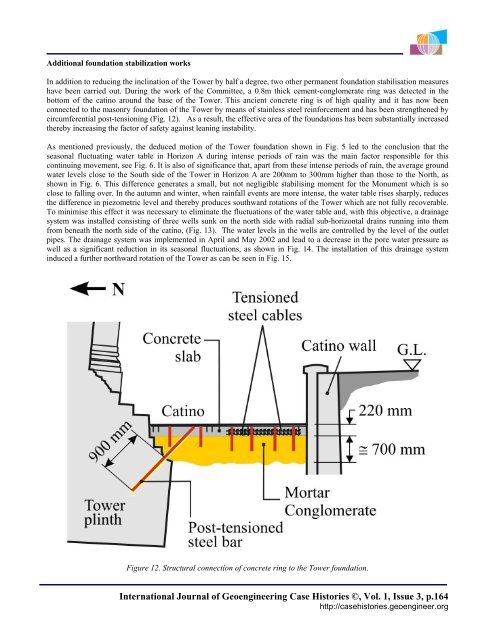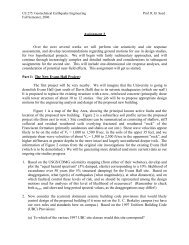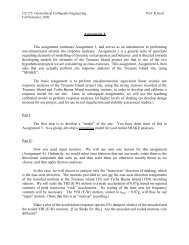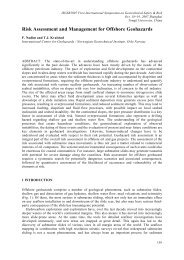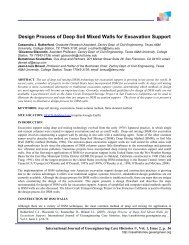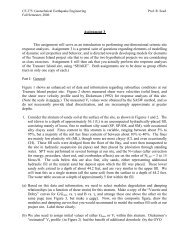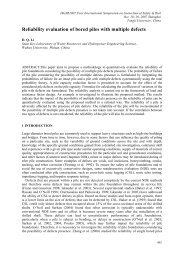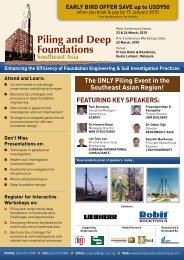Leaning Tower of Pisa: Behaviour after Stabilization Operations
Leaning Tower of Pisa: Behaviour after Stabilization Operations
Leaning Tower of Pisa: Behaviour after Stabilization Operations
- No tags were found...
You also want an ePaper? Increase the reach of your titles
YUMPU automatically turns print PDFs into web optimized ePapers that Google loves.
Additional foundation stabilization worksIn addition to reducing the inclination <strong>of</strong> the <strong>Tower</strong> by half a degree, two other permanent foundation stabilisation measureshave been carried out. During the work <strong>of</strong> the Committee, a 0.8m thick cement-conglomerate ring was detected in thebottom <strong>of</strong> the catino around the base <strong>of</strong> the <strong>Tower</strong>. This ancient concrete ring is <strong>of</strong> high quality and it has now beenconnected to the masonry foundation <strong>of</strong> the <strong>Tower</strong> by means <strong>of</strong> stainless steel reinforcement and has been strengthened bycircumferential post-tensioning (Fig. 12). As a result, the effective area <strong>of</strong> the foundations has been substantially increasedthereby increasing the factor <strong>of</strong> safety against leaning instability.As mentioned previously, the deduced motion <strong>of</strong> the <strong>Tower</strong> foundation shown in Fig. 5 led to the conclusion that theseasonal fluctuating water table in Horizon A during intense periods <strong>of</strong> rain was the main factor responsible for thiscontinuing movement, see Fig. 6. It is also <strong>of</strong> significance that, apart from these intense periods <strong>of</strong> rain, the average groundwater levels close to the South side <strong>of</strong> the <strong>Tower</strong> in Horizon A are 200mm to 300mm higher than those to the North, asshown in Fig. 6. This difference generates a small, but not negligible stabilising moment for the Monument which is soclose to falling over. In the autumn and winter, when rainfall events are more intense, the water table rises sharply, reducesthe difference in piezometric level and thereby produces southward rotations <strong>of</strong> the <strong>Tower</strong> which are not fully recoverable.To minimise this effect it was necessary to eliminate the fluctuations <strong>of</strong> the water table and, with this objective, a drainagesystem was installed consisting <strong>of</strong> three wells sunk on the north side with radial sub-horizontal drains running into themfrom beneath the north side <strong>of</strong> the catino, (Fig. 13). The water levels in the wells are controlled by the level <strong>of</strong> the outletpipes. The drainage system was implemented in April and May 2002 and lead to a decrease in the pore water pressure aswell as a significant reduction in its seasonal fluctuations, as shown in Fig. 14. The installation <strong>of</strong> this drainage systeminduced a further northward rotation <strong>of</strong> the <strong>Tower</strong> as can be seen in Fig. 15.Figure 12. Structural connection <strong>of</strong> concrete ring to the <strong>Tower</strong> foundation.International Journal <strong>of</strong> Geoengineering Case Histories ©, Vol. 1, Issue 3, p. 164http://casehistories.geoengineer.org


